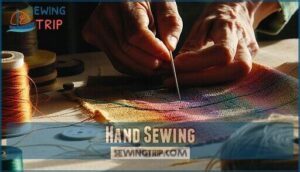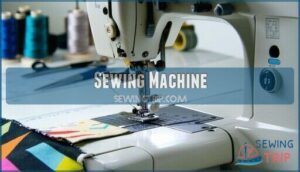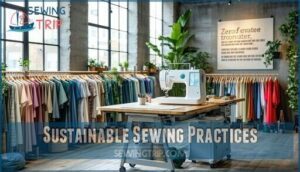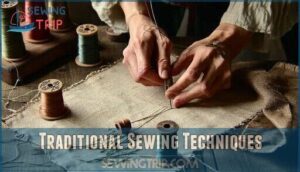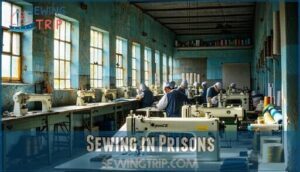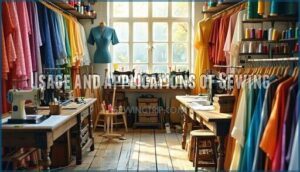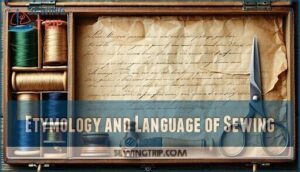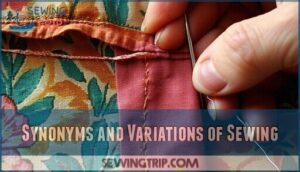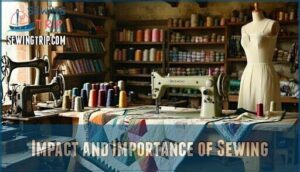This site is supported by our readers. We may earn a commission, at no cost to you, if you purchase through links.
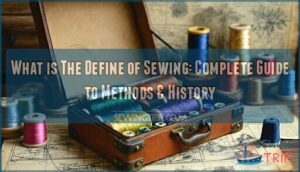 Sewing is the craft of joining fabrics or materials together using needle and thread through various stitching techniques.
Sewing is the craft of joining fabrics or materials together using needle and thread through various stitching techniques.
When you’re wondering what is the define of sewing, think of it as the thread that literally holds our world together – from the clothes on your back to the upholstery in your car.
You’ll find sewing encompasses both hand-stitching and machine work, creating everything from basic repairs to elaborate garments.
This ancient skill transforms raw materials into functional items, decorative pieces, and personal expressions of creativity.
Whether you’re mending a torn seam or crafting a masterpiece, sewing connects practical necessity with artistic vision through time-tested methods.
Table Of Contents
Key Takeaways
- You’ll master a 20,000-year-old craft that joins fabrics using needle and thread, creating everything from basic repairs to complex garments through hand-stitching or machine techniques.
- You’re participating in a skill that serves multiple purposes – practical clothing construction, creative self-expression, therapeutic activity, and sustainable fashion practices that reduce waste.
- You can choose from diverse sewing methods including traditional hand-sewing for precision work, machine sewing for efficiency, specialized techniques like bridal tailoring, and sustainable practices that transform old garments into new pieces.
- You’re connecting with cultural heritage while building modern life skills that offer economic opportunities, from personal clothing design and household repairs to professional careers in fashion and textile arts.
Definition and Purpose of Sewing
Creating garments through sewing represents humanity’s oldest textile craft, transforming loose fabric into functional clothing.
The sewing definition encompasses fastening materials together using stitches made with needle and thread.
This fundamental skill serves multiple purposes beyond basic garment construction.
You’ll discover that sewing’s primary purpose involves creating durable connections between fabric pieces.
The dictionary definition describes it as "the craft of attaching objects using stitches," but this barely captures its true significance.
Sewing enables personal expression, economic independence, and practical problem-solving.
From craft origins dating back 20,000 years, textile attachment methods have evolved dramatically.
Early humans used bone needles to join animal skins, establishing garment fastening techniques we still use today.
Sewing also offers emotional well-being benefits, acting as a therapeutic activity.
Modern sewing history shows how this essential skill built entire industries while maintaining its personal, creative appeal for countless individuals worldwide.
Methods and Techniques of Sewing
You’ll discover that sewing methods range from basic hand stitches using needle and thread to advanced machine techniques that create professional-quality garments.
These fundamental approaches, whether you’re working with traditional hand-sewing or modern equipment, form the foundation for everything from simple repairs to complex tailoring projects, and are essential for creating garments that require professional-quality techniques.
Hand Sewing
When you master hand sewing, you’ll discover the foundation of all sewing techniques.
Start by selecting the right needle types for your fabric—sharp needles for woven materials, ballpoint for knits. Thread selection matters too; match weight to your project.
Learn basic stitches like running stitch and backstitch first. These fundamental skills enable precise fabric manipulation and beautiful hand embroidery.
With practice, your needle becomes an extension of your creativity, transforming simple materials into masterpieces.
Sewing Machine
While hand sewing offers precision and control, sewing machines revolutionize your crafting speed and efficiency.
Modern sewing machines feature diverse Stitch Types, from basic straight stitches to decorative embroidery patterns. These sewing tools handle various Fabric Compatibility challenges, whether you’re working with delicate silk or heavy denim.
Automation Features like automatic threading and tension adjustment make sewing projects less intimidating for beginners. Quilting Machines offer specialized functions for complex layered work. Understanding different machine types can help you choose the right tool for your projects.
Regular Machine Maintenance keeps your equipment running smoothly – clean lint buildup, oil moving parts, and replace needles frequently.
Master different sewing techniques by experimenting with presser feet and stitch settings. Your sewing machine becomes an extension of your creativity, transforming fabric into functional masterpieces with consistent, professional results that’d take hours by hand.
Bridal Tailoring
While sewing machines handle basic stitching, bridal tailoring demands specialized expertise for your once-in-a-lifetime garment. This intricate dressmaking process transforms any gown into your perfect fit through careful gown alterations and custom designs.
The tailoring and alteration services market is experiencing substantial market growth, driven by personalized clothing trends.
Professional tailors follow these essential steps for flawless bridal fashion:
- Analyze fabric selection and garment structure before making adjustments
- Schedule multiple fittings to confirm precise measurements throughout the fitting process
- Employ specialized tailoring techniques that preserve the dress’s original silhouette
- Add personalized beading details or embellishments to reflect your unique style
- Perform final adjustments that accentuate your best features perfectly
Expert tailoring creates your dream wedding dress.
Sustainable Sewing Practices
Beyond creating beautiful bridal pieces, you can embrace sustainable fashion through mindful fabric sourcing and waste reduction.
Choose eco-friendly materials like organic cotton or hemp for your sewing projects.
Transform old garments into upcycling projects rather than discarding them, this repair culture approach extends clothing lifespans while reducing environmental impact.
Sustainable sewing practices help you create meaningful pieces while supporting responsible fashion choices for our planet.
Historical and Cultural Significance of Sewing
You’ll discover that sewing carries deep cultural meaning across civilizations, serving as both a survival skill and an art form that’s connected communities for over 20,000 years.
From Stone Age hunters crafting leather garments to modern quilting circles, you’re participating in traditions that have shaped societies, preserved family histories, and provided economic opportunities throughout human development.
Traditional Sewing Techniques
When cultures develop their unique textile arts, they create lasting legacies through traditional sewing techniques.
You’ll discover that hand stitching methods vary dramatically across regions, with each culture developing distinct approaches to fabric cutting and button sewing.
These sewing traditions encompass heirloom sewing practices that mothers taught daughters for generations.
Today’s seamwork basics still reflect these ancient stitching techniques, proving that traditional hand sewing remains the foundation of modern textile arts and craftsmanship.
Many of these traditions, like Japanese Sashiko techniques, have evolved into decorative art forms, highlighting the importance of traditional hand sewing and heirloom sewing practices in the development of unique textile arts.
Sewing in Prisons
Correctional facilities across America have discovered that teaching inmates to sew creates powerful pathways to redemption.
These rehabilitation programs offer more than just busy work—they’re building bridges to legitimate post-release opportunities.
You’ll find prison industries producing everything from uniforms to upholstery, giving inmates real-world experience in textile production.
Learning this craft transforms idle time into skill development that actually matters.
When you master sewing techniques behind bars, you’re not just creating fabric items—you’re crafting a future.
The occupation becomes a lifeline, connecting incarcerated individuals to sustainable employment and reduced recidivism rates upon release.
The rise of industrial capitalism was substantially influenced by sewing machine innovations.
Usage and Applications of Sewing
You’ll discover that sewing extends far beyond basic clothing creation, encompassing everything from quick repairs and custom alterations to professional fashion design and artistic expression.
Whether you’re fixing a torn seam, crafting personalized gifts, or building a tailoring business, sewing skills offer practical solutions and creative opportunities that adapt to your specific needs and interests.
Personal Clothing Design
Creative expression through sewing transforms ordinary fabric into personalized fashion statements.
Transform simple fabric into your personal fashion story through creative stitching and imaginative design choices.
You’ll discover endless Style Development opportunities when exploring Pattern Alteration techniques that fit your unique body shape.
Smart Fabric Selection becomes your foundation for successful garment construction, while Design Inspiration flows from magazines, social media, and street style.
Modern sewing patterns offer flexibility for customization, letting you experiment with different fabric types and construction methods.
Mastering different sewing techniques guarantees a polished finish.
This Personal Branding approach through clothing design confirms your wardrobe reflects your personality, creating pieces that truly represent your individual aesthetic and lifestyle preferences.
Practical Sewing Needs
Necessity drives most sewing projects at home. You’ll mend torn fabric, replace buttons, and hem pants using basic sewing techniques.
Essential tools like scissors, needles, and thread handle these alterations basics. Fabric selection matters less for repairs than for new garments.
Pattern reading isn’t required for simple fixes. Master seam finishes to strengthen repairs.
Keep sewing supplies handy for quick household fixes and clothing maintenance. A complete sewing kit is useful for these tasks, helping with complete concepts and simple fixes to ensure clothing maintenance.
Sewing Contests and Traditional Items
Sewing contests celebrate both craftsmanship and tradition through competitive needlework displays.
You’ll find regional variations showcasing local techniques, from Appalachian quilting to Southwest embroidery styles.
Contest judging evaluates technical skill alongside creative modern twists on classic patterns.
Heirloom projects often steal the show, featuring grandmother’s vintage lace transformed into contemporary designs.
These skill showcase events preserve traditional sewing techniques while encouraging innovation.
Whether you’re entering handmade garments or decorative pieces, contests provide platforms for demonstrating mastery of both time-honored methods and fresh interpretations of classic needlework traditions.
Contests are essential for preserving traditional sewing techniques and promoting their continuation through new and innovative applications, making them a vital part of the sewing community’s efforts to keep these time-honored methods alive.
Sewing as a Profession or Business
Beyond competitions, many transform their stitching skills into profitable ventures.
Starting a sewing business requires strategic planning and quality equipment. The textile industry offers diverse entrepreneurship opportunities for skilled labor professionals.
A solid plan requires business strategy insights. Consider these business paths:
- Custom sewing services for alterations and repairs
- Fashion design studios creating original garments
- Wedding dress specialty shops
- Home décor item manufacturing
- Teaching sewing classes and workshops
Your needle-and-thread expertise can become a thriving sewing for career fashion.
Etymology and Language of Sewing
You’ll discover that the word "sewing" comes from Middle English, appearing between 1250 and 1300, with roots tracing back over 700 years of linguistic evolution.
Understanding this etymology helps you appreciate how the term has shaped our modern understanding of this essential craft.
That’s been part of human culture since at least 20,000 years ago, making it a significant aspect of our culture.
Origin and Definition of The Term Sew
Looking at practical applications leads us naturally to understanding where it all began. The word "sew" traces its sewing roots through textile history, emerging from Middle English between 1250-1300.
This word origin connects to ancient practices spanning 20,000 years, when early tools made from bone and ivory enabled global sewing traditions across continents.
| Time Period | Tool Material | Region | Technique |
|---|---|---|---|
| 20,000 BCE | Bone/Ivory | Europe/Asia | Animal skins |
| 1250-1300 CE | Metal needles | Medieval Europe | Cloth garments |
| 14th Century | Steel tools | Global | Refined stitching |
| 19th Century | Machine parts | Industrial world | Mechanical sewing |
The sew etymology reveals how this fundamental skill evolved from survival necessity into artistic expression. Sewings evolution demonstrates humanity’s ingenuity in creating both functional and decorative items.
Understanding this meaning and definition shows how the first known use established patterns we still follow today in modern sewing practices.
Merriam-Webster Dictionary Entry
Merriam-Webster’s online sources provide the Official Definition of sewing as "the act, method, or occupation of one that sews." This Dictionary History reveals Word Origin dating before the 12th century.
The dictionary’s Usage Examples show Definition Evolution from simple stitching to complex textile arts.
- Master precise hand techniques through patient practice
- Create beautiful garments that reflect personal style
- Build confidence with each completed project
- Connect with generations of skilled artisans
- Transform fabric into meaningful keepsakes
Synonyms and Variations of Sewing
You’ll encounter many terms that describe the same basic concept of joining fabric with thread, though each carries its own specific meaning.
Understanding these variations helps you communicate more precisely about different sewing activities, whether you’re stitching a seam, hemming a garment, or mending a tear.
Stitching
Stitching forms the backbone of all sewing projects, whether you’re creating decorative stitches or basic seam finishes.
Your needle selection and thread choice determine stitch quality, while proper stitch tension prevents puckering.
Master different stitch types—from running stitches to backstitches—and you’ll tackle any project confidently.
Each sewing stitch serves a specific purpose in your creative toolkit.
Hemming
When your favorite dress is just a bit too long, hemming becomes your go-to sewing solution.
This essential alteration technique involves folding the fabric’s raw edge to create a clean, finished border.
You’ll find various hem types to master: double-fold hems for durability, blind hemming for invisible stitches, and rolled hems for lightweight fabrics.
Curved hems require extra attention around circles and curves.
Different hem lengths suit various garments, while proper hem finishes prevent fraying.
These sewing tips make hemming approachable for beginners, transforming sewing alterations from intimidating tasks into manageable skills that’ll save you countless trips to the tailor.
Mending
Beyond hemming lies the art of giving worn garments new life through mending.
You’ll discover that fabric repair transforms tears into triumphs with the right approach. Whether you’re tackling a favorite sweater or rescuing ripped jeans, these essential techniques will restore your clothing.
- Darning techniques – Weave thread through holes to rebuild fabric structure
- Patching methods – Apply decorative or matching fabric over damaged areas
- Visible mending – Embrace colorful threads that celebrate repair as art
- Alteration skills – Adjust fit while strengthening weak seams simultaneously
Impact and Importance of Sewing
You’ll discover that sewing extends far beyond basic repairs, serving as the foundation for fashion design, creative expression, and sustainable living practices.
Whether you’re crafting functional household items or exploring artistic possibilities, sewing skills connect you to centuries of cultural heritage while meeting modern needs for self-sufficiency and environmental responsibility.
Skill for Tailoring and Fashion Design
You’ll discover that sewing skills form the backbone of successful fashion design and tailoring careers.
Mastering pattern making, garment construction, and textile selection transforms creative visions into wearable art.
Professional designers rely on couture techniques to achieve precise fits and flawless finishes.
Your sewing expertise directly influences design innovation, allowing you to experiment with complex silhouettes and intricate details.
Essential skills include:
- Creating perfect darts that sculpt fabric to body curves
- Installing invisible zippers that disappear into seams
- Hand-finishing buttonholes with surgical precision
- Constructing structured bodices that support and flatter
- Perfecting topstitching that adds professional polish
Fashion design demands technical proficiency alongside artistic vision.
Each stitch you master expands your creative possibilities, enabling you to bring ambitious concepts to life through expert craftsmanship.
Creation of Functional and Decorative Items
Through sewing, you’ll discover the power to transform ordinary fabric into extraordinary functional and decorative treasures.
Whether you’re crafting practical household items or stunning textile art pieces, your needle and thread become tools of endless possibility.
Sewing allows you to create items that serve dual purposes – beauty and utility combined.
You can master fabric manipulation techniques to craft everything from simple pot holders to intricate quilted wall hangings.
Pattern design skills help you develop unique pieces that reflect your personal style.
Here are versatile items you can create:
- Reusable shopping bags with decorative embellishment techniques
- Custom throw pillows featuring mixed media elements
- Handmade baby clothes with delicate stitching details
- Table runners incorporating various textile patterns
- Pet accessories combining function with artistic flair
You’ll find that working with different materials – from cotton scraps to silk ribbons – expands your creative horizons.
Each stitch connects you to generations of makers who understood that handmade items carry special meaning and lasting value.
Exploration in Media and Art
Creative expression threads through modern media as artists transform traditional sewing into powerful storytelling tools.
You’ll find Sewn Sculptures challenging gallery spaces while Embroidered Narratives weave personal histories into fabric.
Fashion Photography captures textile art’s evolution, and Sewing in Film showcases craft as metaphor for human connection and healing.
| Media Type | Artistic Application |
|---|---|
| Film | Sewing as storytelling metaphor |
| Gallery Art | Three-dimensional sewn sculptures |
| Photography | Fashion and textile documentation |
Incorporating Experiences Into Clothing
You can transform ordinary fabric into storytelling garments that capture life’s precious moments.
Memory stitching allows you to weave travel textiles from your adventures into wearable diaries. These emotional fabrics become more than clothes—they’re personal narratives you carry with you.
Sewing for self-expression turns every garment into a meaningful piece of your story.
Frequently Asked Questions (FAQs)
What is the simple definition of sewing?
Like threading a needle through fabric, you’re connecting pieces together through stitches.
You’ll use needle and thread to fasten materials, creating everything from basic repairs to elaborate garments through this timeless craft.
What is considered sewing?
You’re doing sewing whenever you’re fastening materials together with stitches using needle and thread. This includes hand-stitching, machine work, mending clothes, creating garments, embroidery, quilting, and even basic repairs.
How do you explain sewing?
You’re basically joining materials together using thread and needle, creating everything from clothing repairs to decorative pieces. It’s a fundamental craft that combines practical skills with creative expression through stitches.
What are the four types of sewing?
You’ll encounter four main sewing types: hand sewing for detailed work, machine sewing for speed, embroidery for decoration, and quilting for layered projects.
Each serves different purposes in your creative toolkit, with complete concepts being essential for a well-rounded approach.
What are some common mistakes people make when learning how to sew?
Sarah’s first skirt ended up crooked because she skipped measuring twice.
You’ll avoid common pitfalls by cutting fabric properly, threading machines correctly, choosing appropriate needles, pressing seams consistently, and practicing basic stitches before attempting complex projects.
Where can I find sewing classes or lessons in my local area?
You’ll find sewing classes at community colleges, craft stores like Jo-Ann Fabrics, local sewing studios, community centers, and libraries.
Check online directories, Facebook groups, or ask at fabric shops for recommendations in your area.
What tools and equipment do I need to get started with sewing?
Ironically, you’ll need fewer tools than you think to start sewing.
Grab fabric scissors, pins, measuring tape, a seam ripper, thread, needles, and either a basic sewing machine or hand-sewing supplies.
How can I sew clothes that properly fit my body measurements?
Take accurate body measurements using a flexible tape measure, then adjust commercial patterns or draft custom patterns.
Make a muslin test garment first, fit it properly, then transfer those adjustments to your final fabric, following the process to ensure a proper fit.
What safety precautions should beginners follow when sewing?
When Maria’s nephew needed stitches after a sewing accident, she learned that prevention beats treatment.
You’ll want to keep fingers away from moving needles, use proper lighting, store sharp tools safely, and take breaks to avoid fatigue-related mistakes.
How do you choose the right fabric for projects?
Consider your project’s purpose first.
Cotton works well for beginners, while silk demands experience.
Match fabric weight to your pattern—lightweight for flowing garments, heavyweight for structured pieces.
Always check the care instructions.
Conclusion
Understanding what’s the define of sewing opens doors to a world where creativity meets practicality.
You’ve discovered that sewing isn’t just about joining fabrics—it’s about preserving traditions, expressing individuality, and solving everyday problems.
Whether you’re drawn to hand-stitching’s meditative rhythm or machine sewing’s efficiency, you’re connecting with centuries of human ingenuity.
From emergency repairs to haute couture, sewing remains an essential skill that transforms simple materials into meaningful creations that enhance our daily lives, involving everyday problems.

